
How psychology works the facts visually explained (DK) (Z-Library)
.pdf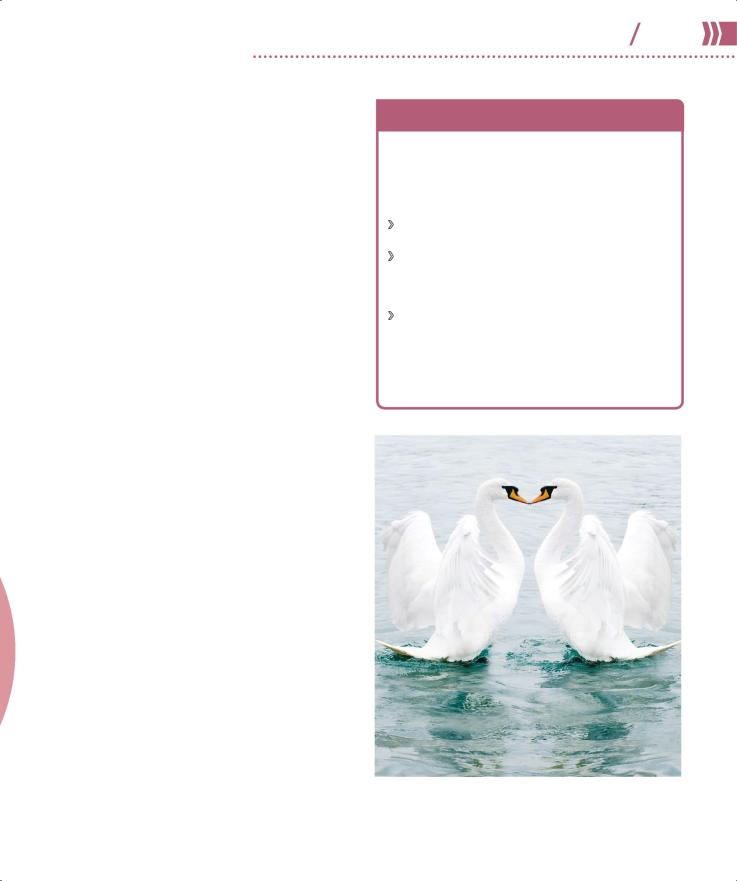
PSYCHOLOGY IN THE REAL WORLD |
158 159 |
The psychology of relationships |
suggested that Commitment = Investment + (Rewards – Costs) – Attractive Alternatives.
More recently, anthropologist Helen Fisher and her colleagues identified three stages of falling in love—lust, attraction, and attachment—which are in part governed by humans’ innate need to reproduce for species survival, though people are usually unaware of this deep-seated urge. Each stage of love is driven by chemicals that affect both emotions and behavior.
The chemistry of love
Many studies point to the role played by the brain’s chemical reactions when a person falls in love. Scientists believe that neurotransmitters flood the brain with chemicals, such as adrenaline, dopamine, and serotonin, that make the person feel on a high, and cause them to constantly think about their partner. This physical reaction is reflected in their behavior. According to research, desire in the first few minutes of meeting is displayed through body language and the tone and speed of voice rather than what is said.
In a study in Italy, psychologists took blood samples from newly infatuated couples and revealed that their serotonin levels were similar to those found in people with OCD (pp.56–57). Scent plays a part, too—a Swiss study found that women preferred the smell of men whose immune systems were genetically different from their own. Though not a conscious preference, their choice of men who had genetically different immune systems would, if translated into a real-life pairing, produce the healthiest offspring.
CHEMICAL ATTRACTION
By taking blood samples from research subjects in different stages of a relationship, scientists have measured the changes that take place in hormone levels at each stage of a relationship, from the first rush of desire through deep attraction to commitment.
Lust The sex hormones—testosterone in men and estrogen in women—drive this first stage of love.
Attraction Adrenaline provides a rush of excitement, quickening the pulse; dopamine gives more energy and less need for sleep and food; and serotonin fuels a happy feeling as well as sexual desire.
Attachment Oxytocin, which is released during orgasm, makes a person feel closer to their partner after sex; vasopressin is also released after sex and is thought to promote an individual’s sense of devotion to their partner.
“Romantic love is … a drive.
It comes from the motor of the mind, the wanting part of the mind, the craving part of the mind.”
Helen Fisher, American anthropologist and researcher
THE SENSE OF SMELL and chemical reactions in the brain are two invisible factors in the mating game and can start a rapid reaction—it takes between 90 seconds and 4 minutes for a person to decide whether they are attracted to someone.
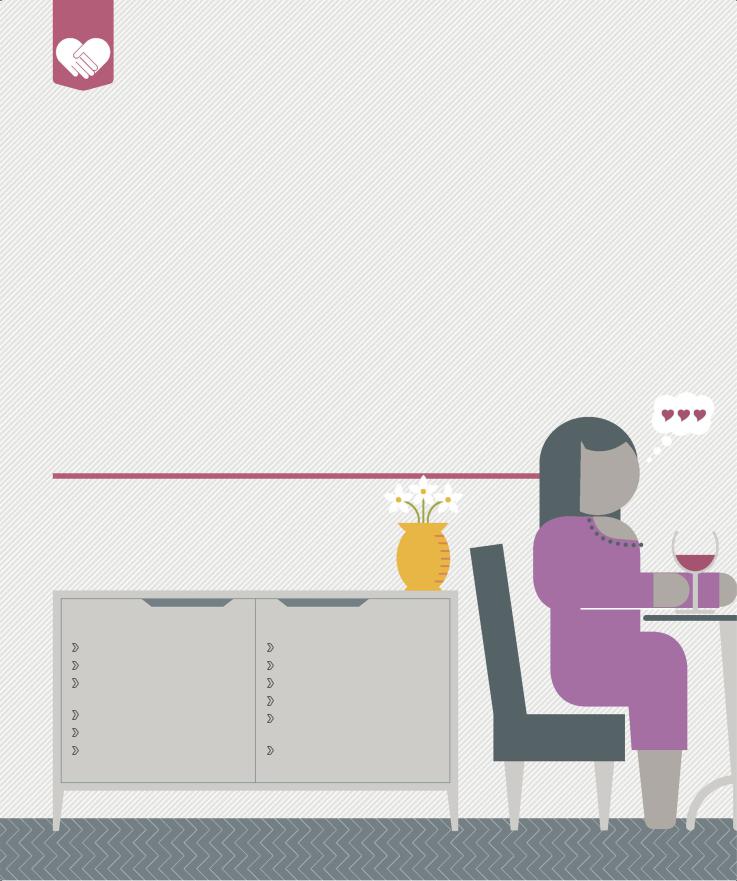
How dating works
Most relationships begin with a date, but this process can often be an anxious one. Understanding the psychology behind dating can help people succeed and help them determine a good match.
The quest for love
Advice on dating may seem the domain of pop psychology, but research into the science of relationships has yielded useful
insights into how people behave during dates, and how to improve the chances of romance.
Psychologists advise adopting the same approach whether finding a partner through traditional or online dating. Dating is a numbers game, and so the chances of finding a compatible partner are slim. The first date should therefore be short—an initial screening— since most serious relationships
start to bloom around the secondor third-date stage. While there is no fail-safe formula for dating success, psychologists emphasize
the importance of keeping an open mind. Physical attraction is usually apparent within the first few minutes of meeting someone, yet according to research, around 20 percent of spouses did not wholly like their partners at first, and only warmed to them on later dates.
For a person who is looking for a serious relationship, there is a simple psychological strategy to employ: a person should gradually reveal their likes and hopes, and
observe how the date responds and behaves in order to evaluate how good a potential match they would make. However, miscommunication and heightened sensitivity can undermine the dating process by causing people to jump to incorrect conclusions—for example, that a delayed response to a text signals a lack of interest, or the fact that someone who is not ready to say
“I love you” means that they do not wish to continue the relationship.
Signs that dates like each other
There are some obvious cues to look for on a first date, while others are so unconscious that they may go unnoticed. As well as body language and speech, there are various theories about what draws people to one partner rather than another.
THE BODY LANGUAGE OF ATTRACTION
Dilating pupils
Tilting the head slightly
Looking at eyes-lips-eyes (the “flirty triangle”)
Smiling to project positive vibesMirroring body language
Stroking hair, fiddling with necklace, blushing
Leaning in toward date
Pulling sleeves up to show wrist
Touching accidentally
Pointing feet at date
Changing the volume or pitch of voice (women)
Laughing, interrupting, and varying volume of speech (men)

Matching hypothesis
According to the matching theory developed by Elaine Hatfield and her colleagues, people are likely to form relationships with those who resemble them and hold a similar social position and level of intelligence. Such individuals are more attainable than someone “out of a person’s league.”
PSYCHOLOGY IN THE REAL WORLD |
160 161 |
The psychology of relationships |
Filter modeling
According to Alan Kerckhoff and Keith Davis, relationships go through three filtering stages. The first involves assessing similarities in background, education, and location; the second, looking for similar beliefs and attitudes; and the third, complementing each other’s needs. People who are too different are filtered out.
Reward/need theory |
Social exchange |
Donn Byrne and Gerald |
Caryl Rusbult’s theory (p.158) |
Clore’s theory shows that |
indicates that people stay in |
people are most attracted to |
a relationship if the benefits, |
potential partners who meet |
such as gifts, outweigh costs, |
their needs for friendship, |
including time and money |
sex, love, and feeling good. |
invested in it. |
First-date self-disclosure
People expect that when they reveal information about themselves on a first date it will be reciprocated. If their date does not follow suit, the person may be revealing too much, or their date may not be interested. If a date does like the person who discloses first, however, they will probably like them even more for sharing.
DATING COACHING
For those who are having trouble attracting a long-term partner or feel they are attracting the wrong kind of person, a psychologically qualified dating coach may be able to help. Dating coaches train their clients to communicate more confidently and to hone important dating skills such as flirting, body language, personal
presentation, and how to pace the rate of self-disclosure. A dating coach can also explore any psychological barriers that a client may be putting up; can help the client to develop a realistic profile of the kind of person they want to meet; and can advise them on strategies for meeting more compatible prospects.

Psychology and the stages of relationships
Psychologists have developed frameworks that explain how relationships grow and break down, and help people recognize the phases and navigate between them.
The stages of a relationship
After decades of study, psychologists have determined what most people experience in life but are often too blinded by love to see. Relationships are built in stages, and each stage brings its own developments, along with challenges that both parties have to meet before moving on to the next level.
One of the most cited relationship models is that of psychologist Mark Knapp, who visualized a flight of stairs going up to explain how a partnership builds, a plateau where the two maintain the bond, and a flight of stairs down
Tools for maintaining
Forgive minor transgressions, downplay faults, and emphasize each other’s virtues to keep closeness in the relationship.
Spend time together as a couple.
Bonding
The couple’s lives are fully intertwined. They make their love public and may discuss marriage or some other permanent bond.
Knapp’s relationship model
Envisaged as a metaphor for relationships building and breaking down, Knapp’s staircase has five steps up as a relationship builds step by step—and five steps back down in the event of a couple breaking up. His model provides an insight into where things can go wrong and the different challenges that couples may face.
Integrating
The relationship becomes much closer, and the couple integrates aspects of their lives. Both are willing to be vulnerable, including making declarations of love.
COMING TOGETHER
ROMANTIC RELATIONSHIPS
Intensifying
Both parties start to reveal more personal information and let their guard down. Feelings intensify as they nurture the relationship, and both sides start to expect commitment.
Experimenting
The two parties discover more about each other, probing for information and common interests so that they can make a decision as to whether to continue in the relationship.
Initiating
Usually a very short stage, this is when first impressions count. Dates express an interest and size each other up, taking into account appearance, dress, body language, and voice.
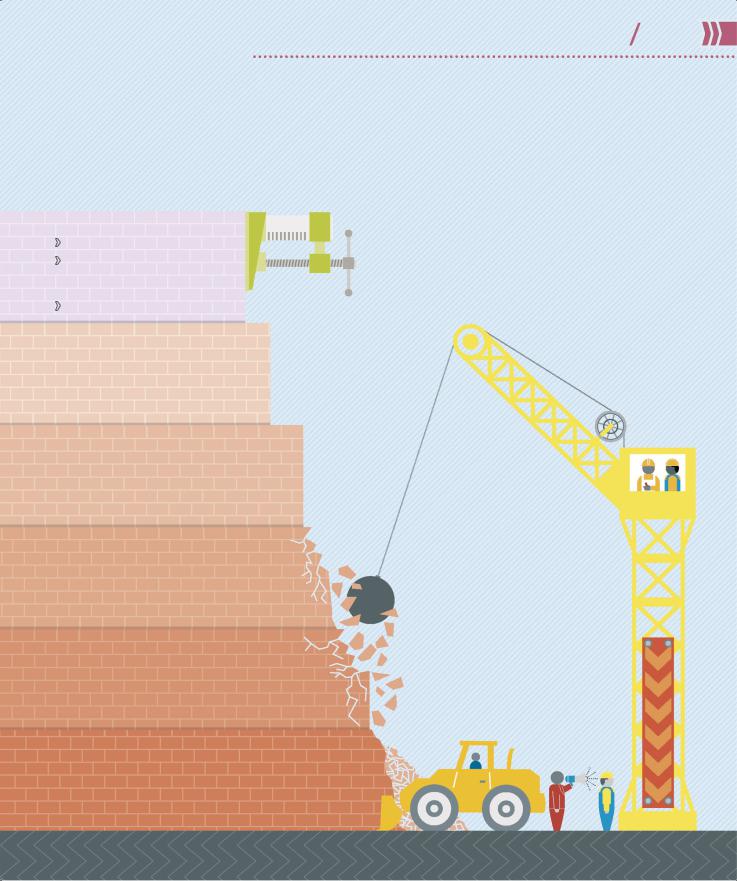
PSYCHOLOGY IN THE REAL WORLD |
162 163 |
The psychology of relationships |
if a relationship deteriorates. By segmenting these processes into clear steps, Knapp’s model offers couples the tools to work out where they are in a relationship at any given time, predict where it may be going, and make necessary changes. The speed at which partners negotiate these steps may vary. They
the relationship
Merge friendship networks.
Do favors for one another; be willing to put own needs on hold to help partner.
Maintain mutual affection levels.
Differing
As the pressures of life cause stress, both people see themselves less as a couple and more as individuals.
Their bond seems to be broken.
may also skip whole steps if the relationship is either progressing or unraveling rapidly.
Progress and decline
After analyzing her own marriage, psychologist Anne Levinson developed a simple five-stage model for how relationships progress and decline. She applied this not only to romantic partnerships but also to consumer relationships, and likened the rapport between sexual partners as similar to that between a brand and shoppers, who are seduced, are won over, commit for a time, and then either stay committed or move on for
a range of reasons. The first stage of her model is Attraction, followed by Build-up and Commitment,
before Deterioration if the partnership is not working,
and finally Ending.
Circumscribing
Brewing resentment creates barriers and reduces levels of communication. The couple may even stop meaningful communication for fear of an argument.
Stagnating
The relationship declines rapidly and is unlikely to improve. Communication is even more limited. But some couples may stay together for their children.
Avoiding
Communication is nonexistent and the pair lead separate lives, even if under the same roof. They may be tempted to get back together to avoid the painful reality of a permanent split.
Terminating
The relationship is over. Married couples finalize divorce. Both parties move to separate homes, if they have not already done so, and lead their own separate lives.
48%
of men fall in love at first sight compared to
28% of women
APART COMING

PSYCHOLOGY AND THE STAGES OF RELATIONSHIPS
Talking to each other
The way in which a couple communicates can have a dramatic effect on their relationship, and awareness of conversational patterns can make the difference between a relationship growing and falling apart. Psychologists maintain that a person can improve their partner choices from the outset as well as the quality of their relationships by understanding the mechanisms of communication and looking for warning signs.
From the opening moments of meeting a potential partner, how much an individual reveals about themselves—what psychologists call self-disclosure—has a significant impact on what happens next. Early on, most couples share as much information as possible with each other, starting with superficial topics and moving on to more personal details such as hopes for the future. However, if one partner reveals much more information
than the other, they may feel that the other is less invested in the relationship. Revealing intimate information too early on can also be intimidating when neither person feels ready to commit.
Good communication is crucial to keep a relationship from declining, but sometimes this is still not enough. Social psychologist Steve Duck identifies four ways in which a relationship breaks down: “preexisting doom” due to a basic mismatch; “mechanical failure” because of poor communication; “process loss” from not reaching its full potential, again because of a lack of communication; and
“sudden death” due to a violation of trust. Relationship expert John Gottman also explains breakups as a direct consequence of poor communication (below and right).
The finish line
Negative communication can kill a couple’s love in four stages, according to research by John Gottman and fellow psychologists Coan, Carrere, and Swanson. Their explanation for how this happens is called The Four Horsemen of the Apocalypse after the biblical harbingers of doom because each stage is an omen of the death
of a relationship.
65%
of divorces stem from communication problems
COMMUNICATION IN RELATIONSHIPS
American professor of psychology John Gottman is renowned for his research into family systems and marriage. His ideas have been hugely influential in relationship psychology and in couples therapy, and form the basis of The Gottman Method Couple’s Therapy. After observing thousands of couples, Gottman maintains that a gentle communication style—which involves active, not reactive, listening—enables couples to recover and repair the damage after a serious argument.
Reactive listening
Taking things personally and feeling defensive about what a partner is saying is almost guaranteed to inflame the conversation. Instead of instantly denying what is being said, with replies such as “That’s not true” and “No, I don’t,” the key, according to Gottman, is for a person to be realistic and reflect on whether their own behavior may have been annoying. Turning the tables on a partner to deflect selfindignation, with comments along the lines of “At least I’m not …” or “You’re overreacting,” is to be avoided.
Active listening
The person should focus on expressing how they feel about a situation rather than making sweeping statements. When
responding, Gottman recommends starting sentences with “I” instead of “You”—for example, “I feel you are not listening to me,” rather than “You’re not listening”—to diffuse a potentially volatile conversation. Controlling tone of voice and volume reinforces this conciliatory and constructive approach to resolving differences.
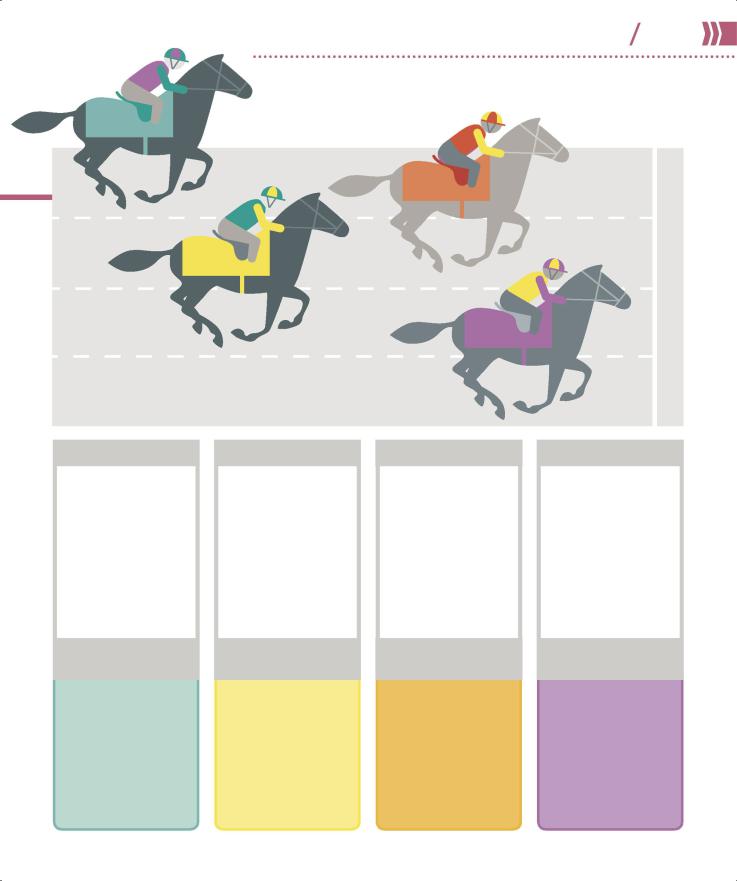
PSYCHOLOGY IN THE REAL WORLD |
164 165 |
The psychology of relationships |
CRITICISM
DEFENSIVENESS
CRITICISM |
DEFENSIVENESS |
Stage 1 Verbally |
Stage 2 Reacting |
attacking a partner’s |
negatively to criticism |
character or |
by making excuses |
personality rather |
and blaming the |
than tackling the |
other person, |
annoying behavior |
rather than taking |
together. This can |
responsibility for a |
make the other person |
part in the conflict. |
feel negatively about |
This increases feelings |
themselves. |
of dissatisfaction. |
CONTEMPT
BREAKUP
STONEWALLING
CONTEMPT |
STONEWALLING |
Stage 3 Being |
Stage 4 Withdrawing |
rude and showing |
by cutting off physical |
open disrespect |
and emotional contact |
through facial |
with a partner, who |
expressions such |
feels abandoned |
as rolling the eyes. |
and rejected. |
Both parties have |
Stonewalling can |
to work hard to |
happen when the |
regain respect from |
first three stages are |
one another. |
overwhelming. |
Constructive alternative
Actively listen to your partner, and express your feelings about them rather than attacking them directly. Focus on explaining why their behavior annoys you rather than their personal qualities.
Constructive alternative
Be prepared to apologize for your own behavior and to take responsibility for it if appropriate. Listen to your partner and try to understand their dissatisfaction; try not to take it personally.
Constructive alternative
Think about causes of your own behavior and why it is hard to express upset feelings in a constructive way. Focus on your partner’s positive attributes instead of keeping score of their flaws.
Constructive alternative
Let your partner know when you need time to yourself to think, and resume conversation when you are ready. This way, your partner will understand that your aim is not to reject them.

Psychology in education
The primary aim of educational psychology is to identify the most effective ways of learning. Educational psychologists research and observe how the brain processes information and solves problems, how memory works, and how external factors such as peers and even classroom layouts can affect learners. Their research can then be applied to help children and adults as they learn and to help those with behavioral and learning issues, too.
Strategies to improve learning
Educational psychologists can suggest a range of strategies to help learners improve how they acquire and retain information. Encouraging
students to work alone to achieve their own goals can be beneficial, but it is also important to share knowledge and work together to improve group solidarity and foster confidence.
“The principal goal of education in the schools should be creating men and women … capable of doing new things.”
HOW WE LEARN
Individuals retain information best when they are motivated to learn and are committed to improving their skills. Working alone fosters independence and a sense of individual achievement.
Jean Piaget, Swiss clinical psychologist
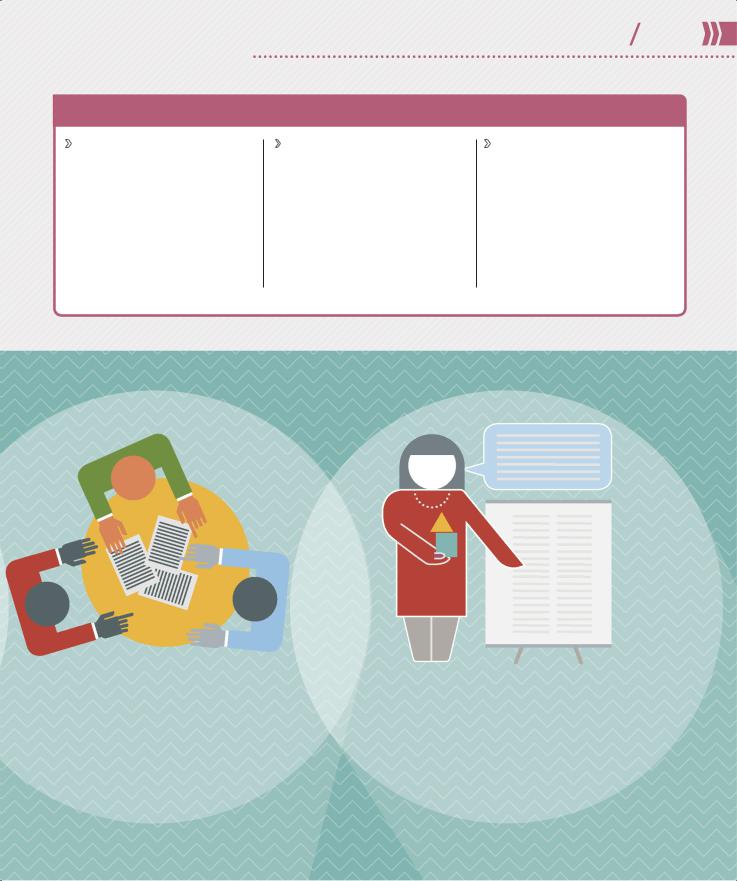
PSYCHOLOGY IN THE REAL WORLD |
166 167 |
Psychology in education |
WHERE EDUCATIONAL PSYCHOLOGISTS WORK
Schools The most common employment settings for educational psychologists are schools and educational institutions. Here they advise on how to improve teaching effectiveness by offering analysis and programs. They instruct on better ways to manage classrooms, train teachers, and identify problem learners and instigate special education when needed.
Businesses In the corporate setting, educational psychologists may work in-house or as consultants for companies wanting to improve the effectiveness of their staff.
They develop and administer psychometric testing to screen new recruits for ability and honesty, and run specialist training for staff to improve employee motivation and performance.
Government Here psychologists provide vital support as they advise on educational policy. They develop curriculums and learning strategies for teachers in the state school system, advise on ways to help children with learning difficulties, and train the staff who provide such support. Their role also involves helping to train specialist personnel, especially for military roles.
CLASSROOM STRUCTURE
Activities in small groups encourage questions and build confidence. If a learning environment is emotionally
and physically safe, individuals are more likely to test ideas.
TEACHING METHODS
Teachers can use a range of tools to reinforce learning, such as using more than one way to explain each concept, breaking down information into chunks, and encouraging active participation.
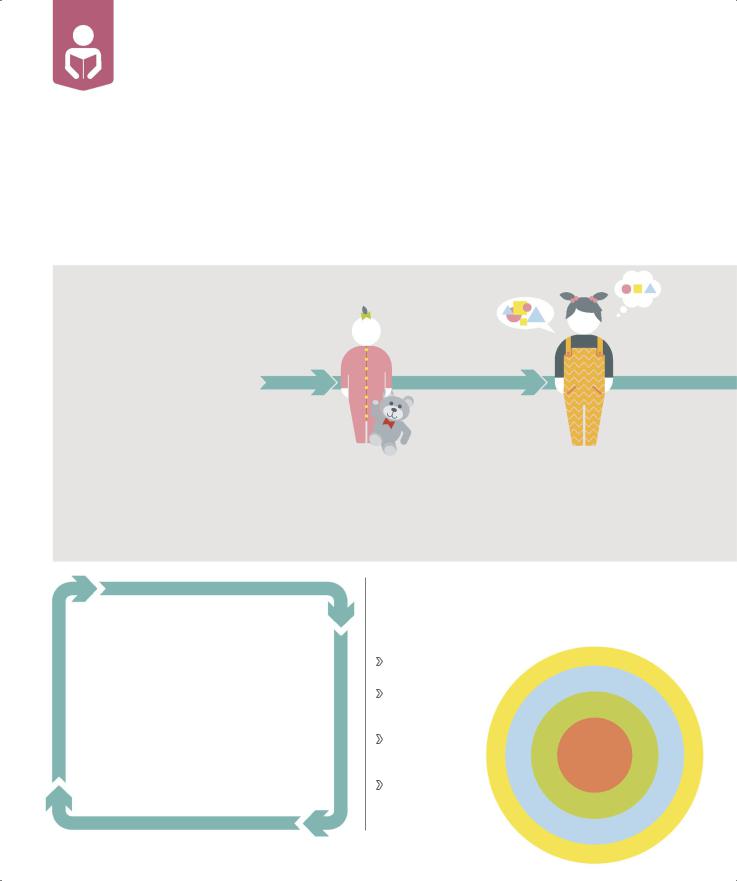
Educational theories
The complex methods by which people process, memorize, and retrieve information—and then develop independent thought—can be interpreted through a range of theories.
In the classroom
As science and research techniques have advanced, so have ideas about how the mind receives new information and retains it. Applying these ideas in
the classroom can be beneficial. An early, but still dominant, idea is cognitive learning theory (CLT), based on the work of influential psychologist Jean Piaget. CLT proposes that learning is the result
Piaget’s theory of cognitive development
Jean Piaget believed that as people develop from babies to adults, they build a vast series of knowledge units that shape the way they understand the world. Every time they encounter something new, they draw on their previous knowledge to assimilate it. When they cannot, they are forced to learn and accommodate new information.
SENSORIMOTOR STAGE |
PREOPERATIONAL STAGE |
(0−2 YEARS) |
(2−7 YEARS) |
The first knowledge to develop is |
Children begin to develop language abilities |
understanding that an object can exist even |
but do not yet grasp logic. However, they are |
when it cannot be seen, known as object |
starting to use symbols and understand that |
permanence—for example, knowing that |
an object can represent something else— |
a toy is simply hidden under a blanket. |
pretending a doll is a person, for example. |
TESTING IDEAS IN PRACTICE
EXPERIENCE
Kolb’s experiential learning cycle
David Kolb built on Piaget’s work, publishing his four-part theory in 1984. His cycle of learning has four connected stages that form a continuing process. Initially, concrete experiences lead to reflective observations about what has been experienced. These observations are then translated into abstract concepts—in other words, ideas are developed. The fourth stage is putting these ideas into practice, which Kolb called “active experimentation.”
DEVELOPMENT OF IDEAS
OBSERVATIONS/REPETITIONS
Race’s ripple theory
Devised by Professor Phil Race, the ripple model offers an alternative to Kolb’s cycle. It involves four integrated processes that intersect like ripples on a pond, with a basic need or desire at its core.
|
|
|
|
EE |
D |
BA |
C |
|
|
1. Motivation Learning |
|
-F |
|
|
|
K |
|||
4 |
|
|
|
|
|
|
|||
starts with an aspiration. |
- |
IGESTI |
N |
|
|||||
2. Practice Trial and |
3 |
D |
|
|
|
|
G |
||
|
|
|
|
|
|
|
|||
|
|
|
|
|
|
|
|
|
|
error drives action |
|
|
|
-DOIN |
G |
|
|||
and discovery. |
|
2 |
|
|
|
||||
|
|
|
|
|
|
|
|
|
|
3. Making sense |
1-NEEDING/ |
||||||||
Discoveries are |
|||||||||
digested. |
|
|
WANTING |
||||||
|
|
|
|
|
|
|
|
|
|
4. Seeing results
Feedback affects motivation.
